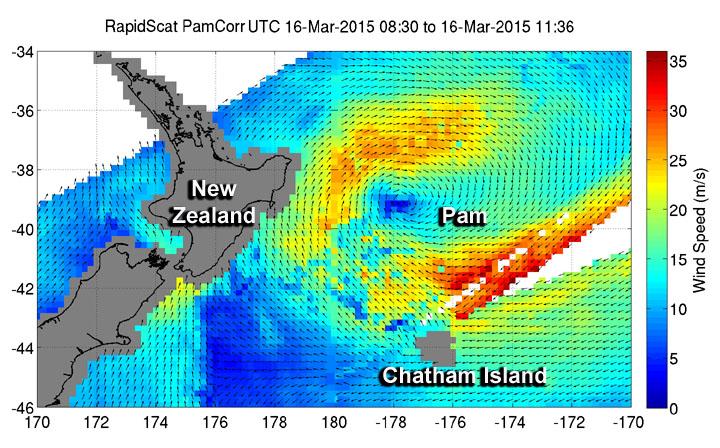RapidScat eyes Ex-Tropical Cyclone Pam's winds near Chatham Islands

RapidScat revealed sustained winds over 30 meters per second/108 kph/67 mph (in red) were still occurring southeast of Pam's center on March 16. Image Credit: NASA JPL/Doug Tyler
The International Space Station's RapidScat instrument captured data on Ex-Tropical Cyclone Pam's winds on March 16 from 08:30 to 11:36 UTC.
RapidScat revealed sustained winds over 30 meters per second (108 kph/67 mph) were still occurring southeast of the center.
The forecast calls for southwesterly winds to 50 knots (57 mph/92 kph) with high seas easing. The “easterly swell 4 meters and southwest swell rising to 7 meters. Poor visibility in heavy rain at times.
On March 17 (or 12:17 a.m. local time, March 18), the New Zealand Meteorlogical Service bulletin stated “Ex Tropical Cyclone Pam lies southeast of the Chatham Islands today, leaving a south to southwest flow over New Zealand.
A ridge moves onto New Zealand on Thursday.” For updated forecasts,visit: http://www.
Media Contact
All latest news from the category: Earth Sciences
Earth Sciences (also referred to as Geosciences), which deals with basic issues surrounding our planet, plays a vital role in the area of energy and raw materials supply.
Earth Sciences comprises subjects such as geology, geography, geological informatics, paleontology, mineralogy, petrography, crystallography, geophysics, geodesy, glaciology, cartography, photogrammetry, meteorology and seismology, early-warning systems, earthquake research and polar research.
Newest articles

Sea slugs inspire highly stretchable biomedical sensor
USC Viterbi School of Engineering researcher Hangbo Zhao presents findings on highly stretchable and customizable microneedles for application in fields including neuroscience, tissue engineering, and wearable bioelectronics. The revolution in…

Twisting and binding matter waves with photons in a cavity
Precisely measuring the energy states of individual atoms has been a historical challenge for physicists due to atomic recoil. When an atom interacts with a photon, the atom “recoils” in…

Nanotubes, nanoparticles, and antibodies detect tiny amounts of fentanyl
New sensor is six orders of magnitude more sensitive than the next best thing. A research team at Pitt led by Alexander Star, a chemistry professor in the Kenneth P. Dietrich…





















